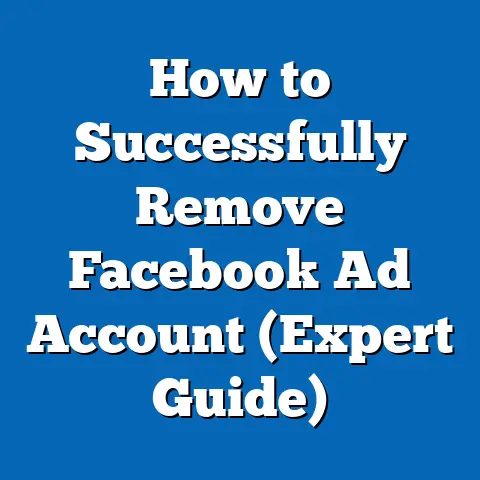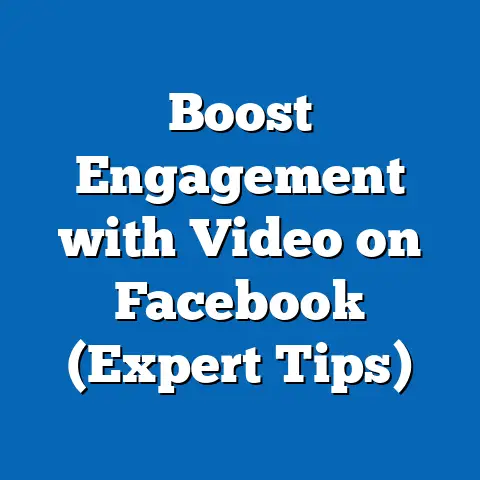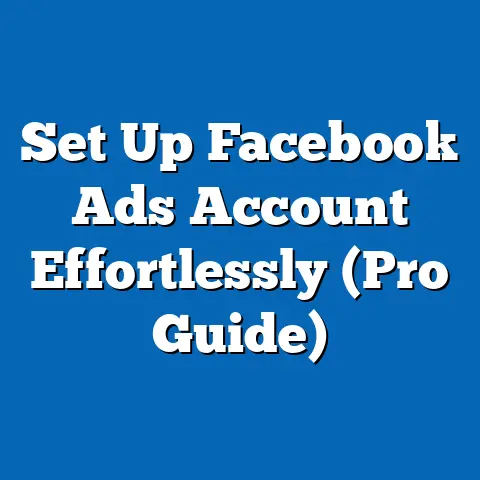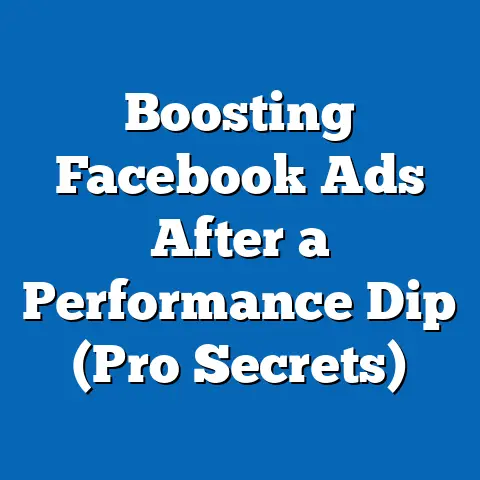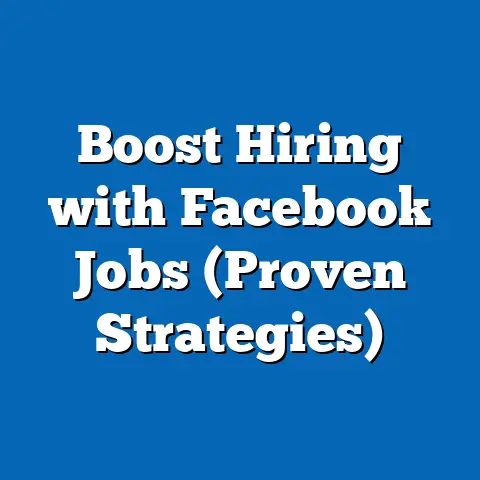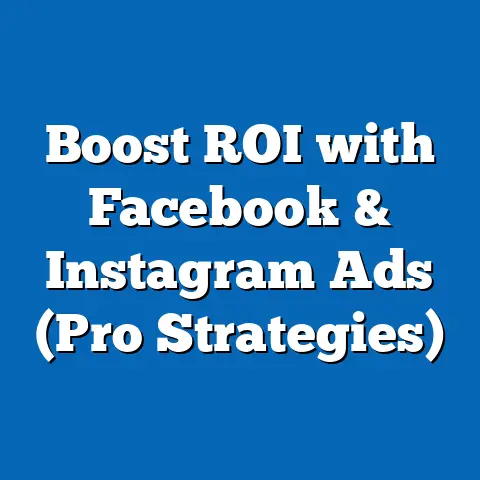Crafting Irresistible Facebook Ad Copy (Proven Strategies)
Would you rather have your ad seen by a million people who scroll right past, or have 100 people see your ad and generate a hundred sales? The answer, I hope, is obvious. In today’s digital world, simply getting eyeballs on your ad isn’t enough. You need compelling ad copy that grabs attention, sparks interest, and ultimately drives conversions.
Facebook advertising has become a cornerstone of many marketing strategies, and for good reason. With billions of users, the platform offers unparalleled reach and targeting capabilities. However, this also means your ads are competing with countless other brands, influencers, and even your friends’ vacation photos. That’s why crafting irresistible Facebook ad copy is no longer a nice-to-have; it’s a necessity.
I’ve spent years honing my skills in the trenches of Facebook advertising, and I’ve seen firsthand what works and what doesn’t. I’ve witnessed campaigns soar to success with the right words and imagery, and I’ve also seen promising products fall flat due to lackluster ad copy. In this article, I’m going to pull back the curtain and unveil proven strategies for crafting Facebook ad copy that not only resonates with your audience but also drives tangible results. We’ll explore how to deeply understand your audience, write attention-grabbing headlines, craft engaging body copy, optimize for Facebook’s unique format, and continuously analyze and refine your ads for maximum impact. Let’s dive in and transform your Facebook ads from ignored noise into conversion machines!
Understanding Your Audience
Before you even think about writing a single word of ad copy, you need to understand who you’re talking to. Imagine trying to sell a vegan cookbook to a group of die-hard barbecue enthusiasts – it’s simply not going to work. Similarly, generic, one-size-fits-all ad copy will likely fall flat. That’s why the foundation of any successful Facebook ad campaign is a deep understanding of your target audience.
Researching Your Target Demographic
Facebook Insights (now known as Meta Business Suite Insights) is your best friend here. It’s a treasure trove of data about your existing followers and potential customers. I’ve spent countless hours poring over this data, and it’s always revealed valuable insights.
- Demographics: Age, gender, location, education level, relationship status – these are the building blocks of your audience profile.
- Interests: What pages do they like? What topics do they engage with? This gives you a glimpse into their passions and hobbies.
- Behaviors: What are their online shopping habits? What devices do they use? This helps you understand their digital footprint.
But don’t limit yourself to Facebook Insights. Explore other analytics tools like Google Analytics to understand the behavior of your website visitors. Conduct customer surveys and interviews to gather qualitative data. Ask questions like:
- What are their biggest challenges related to your product or service?
- What motivates them to make a purchase?
- What language do they use to describe their needs?
The more data you gather, the clearer picture you’ll have of your ideal customer.
Takeaway: Use Facebook Insights and other analytics tools to gather data on your audience’s demographics, interests, and behaviors. Supplement this with customer surveys and interviews to understand their motivations and challenges.
Creating Audience Personas
Once you’ve gathered your data, it’s time to create audience personas. These are fictional representations of your ideal customers, based on your research. A well-defined persona goes beyond basic demographics and delves into their motivations, goals, and pain points.
For example, let’s say you’re selling a project management software. You might create a persona named “Sarah, the Overwhelmed Project Manager.”
- Demographics: Female, 35 years old, lives in Chicago, Bachelor’s degree.
- Job Title: Project Manager at a small marketing agency.
- Goals: To deliver projects on time and within budget, to improve team collaboration, and to reduce stress.
- Pain Points: Overwhelmed by juggling multiple projects, struggling to keep track of deadlines, frustrated by poor team communication.
- Quote: “I feel like I’m constantly putting out fires. I need a better way to manage my projects and keep my team on the same page.”
By creating this detailed persona, you can start to tailor your ad copy to address Sarah’s specific needs and pain points. You can highlight how your project management software can help her reduce stress, improve team collaboration, and deliver projects on time.
I’ve found that creating physical representations of my personas – like printing out a photo and writing their key attributes on a whiteboard – helps keep them top of mind when crafting ad copy. It’s a constant reminder of who I’m trying to reach and what matters most to them.
Takeaway: Create detailed audience personas that represent different segments of your target audience. Understand their motivations, goals, and pain points to tailor your ad copy effectively.
The Role of Emotional Triggers
Emotions are powerful drivers of consumer behavior. People don’t just buy products or services; they buy solutions to their problems, fulfillment of their desires, and validation of their values. By tapping into these emotions, you can create ad copy that resonates on a deeper level and motivates people to take action.
Here are some common emotional triggers you can use in your Facebook ad copy:
- Fear: Highlight the potential consequences of not using your product or service. (e.g., “Don’t let your business fall behind. Get our SEO audit today!”)
- Greed: Emphasize the benefits and value your product or service offers. (e.g., “Unlock your earning potential with our online course.”)
- Curiosity: Intrigue your audience with a question or statement that piques their interest. (e.g., “The one secret ingredient that will transform your cooking.”)
- Hope: Offer a solution to their problems and a brighter future. (e.g., “Finally, a solution to your chronic back pain.”)
- Belonging: Create a sense of community and connection. (e.g., “Join our community of passionate entrepreneurs.”)
I remember working on a campaign for a financial planning service. Instead of focusing on dry statistics and investment jargon, we tapped into the emotional trigger of hope. We painted a picture of a secure retirement, a comfortable life, and the ability to pursue their passions without financial worries. This resonated far more than any technical explanation of investment strategies.
Takeaway: Incorporate emotional triggers into your ad copy to connect with your audience on a deeper level. Understand their fears, desires, and aspirations, and tailor your messaging accordingly.
Crafting Compelling Headlines
The headline is the first, and often only, thing people see when they encounter your Facebook ad. It’s your chance to make a strong first impression and capture their attention in a sea of competing content. Think of it as the storefront of your ad – if it’s dull and uninviting, people will simply walk on by.
The Importance of Headlines
In the fast-paced world of social media, attention spans are shorter than ever. People are constantly bombarded with information, and they quickly filter out anything that doesn’t immediately grab their interest. That’s why your headline needs to be clear, concise, and compelling. It needs to instantly convey the value proposition of your ad and give people a reason to click.
I’ve seen countless ads with amazing products or services fail simply because their headlines were weak and uninspired. They didn’t capture attention, they didn’t create curiosity, and they didn’t motivate people to learn more.
Takeaway: Headlines are the first impression of your ad and can determine whether someone clicks. Make them clear, concise, and compelling to capture attention.
Tips for Writing Attention-Grabbing Headlines
Here are some proven techniques for writing headlines that stop the scroll:
- Use Numbers and Lists: Numbers are naturally eye-catching and suggest a clear, organized benefit. (e.g., “5 Ways to Boost Your Business’s Social Media Engagement,” “3 Common Mistakes to Avoid When Investing”)
- Ask Questions that Spark Curiosity: Questions can pique people’s interest and make them want to learn more. (e.g., “Are You Making These Common Marketing Mistakes?” “Do You Know the Secret to a Perfect Cup of Coffee?”)
- Utilize Powerful Adjectives and Strong Verbs: Choose words that evoke emotion and create a sense of excitement. (e.g., “Discover the Revolutionary New Skincare Solution,” “Unleash Your Inner Artist with Our Online Workshop”)
- Highlight a Specific Benefit: Clearly state the value proposition of your product or service. (e.g., “Get Instant Relief from Back Pain with Our New Ergonomic Chair,” “Save Time and Money with Our Automated Accounting Software”)
- Create a Sense of Urgency: Encourage people to take action now by creating a sense of scarcity or time sensitivity. (e.g., “Limited Time Offer: Get 50% Off Our Premium Subscription,” “Don’t Miss Out: Our Workshop Starts Next Week!”)
I once ran a campaign for a local restaurant that was struggling to attract new customers. We experimented with different headlines, and the one that performed the best was: “Craving Authentic Italian Food? Discover [Restaurant Name], Your New Favorite Spot!” This headline combined a question that sparked curiosity with a clear benefit and a sense of local discovery.
Takeaway: Use numbers, questions, powerful adjectives, and specific benefits to create attention-grabbing headlines. Don’t forget to create a sense of urgency to encourage immediate action.
A/B Testing Headlines
The best way to determine which headlines resonate most with your audience is to A/B test them. This involves creating multiple versions of your ad with different headlines and then tracking their performance to see which one generates the most clicks, conversions, or other desired outcomes.
Facebook Ads Manager makes A/B testing relatively easy. You can create multiple ad sets within the same campaign and then vary the headlines in each ad set. Make sure to keep all other variables constant (targeting, budget, visuals) so that you can accurately attribute the results to the headline.
When analyzing the results, pay attention to metrics like:
- Click-Through Rate (CTR): The percentage of people who saw your ad and clicked on it.
- Conversion Rate: The percentage of people who clicked on your ad and then completed a desired action (e.g., made a purchase, filled out a form).
- Cost Per Click (CPC): The average cost you pay for each click on your ad.
I typically run A/B tests for at least a week, or until I have enough data to confidently determine a winner. Once I’ve identified the best-performing headline, I’ll use it as the foundation for future ad copy and continue to test variations to further optimize my results.
Takeaway: A/B test different headlines to determine which resonates best with your audience. Track key metrics like CTR, conversion rate, and CPC to identify the winning headline.
Writing Engaging Body Copy
While the headline grabs attention, the body copy is where you seal the deal. It’s your opportunity to tell your story, highlight your value proposition, and persuade people to take action. Think of it as the heart of your ad – if it’s weak or unconvincing, people will lose interest and move on.
The Structure of Effective Ad Copy
Effective ad copy typically follows a clear structure, often referred to as AIDA:
- Attention: Grab the reader’s attention with a compelling opening line or question.
- Interest: Spark their interest by highlighting a problem or need they have.
- Desire: Create desire for your product or service by showcasing its benefits and value.
- Action: Motivate them to take action with a clear and compelling call to action.
I’ve found that starting with a problem-agitation-solution (PAS) framework can also be highly effective. This involves:
- Problem: Identifying a specific problem your target audience is facing.
- Agitation: Agitating the problem by highlighting its negative consequences.
- Solution: Presenting your product or service as the solution to their problem.
No matter which framework you choose, it’s crucial to lead with benefits rather than features. People don’t care about the technical specifications of your product; they care about how it will improve their lives. Instead of saying, “Our software has advanced AI algorithms,” say, “Save hours of time and automate your marketing tasks with our AI-powered software.”
Takeaway: Use a clear structure like AIDA or PAS to guide your ad copy. Lead with benefits rather than features to highlight the value proposition of your product or service.
Using Storytelling Techniques
Storytelling is a powerful way to captivate audiences and create a connection. People are naturally drawn to stories, and they’re more likely to remember information that’s presented in a narrative format.
Instead of simply listing the features of your product, try telling a story about how it has helped someone solve a problem or achieve a goal. This could be a customer testimonial, a case study, or even a fictional scenario.
For example, let’s say you’re selling a weight loss program. Instead of saying, “Our program helps you lose weight,” you could tell a story about a customer who struggled with their weight for years and finally achieved their goals with your program. You could share their before-and-after photos, their personal struggles, and their ultimate triumph.
I’ve found that using vivid language and sensory details can make your stories even more engaging. Describe the sights, sounds, smells, and emotions of the experience. This will help your audience feel like they’re right there with the person in the story.
Takeaway: Use storytelling techniques to captivate your audience and create a connection. Share customer testimonials, case studies, or fictional scenarios that highlight the benefits of your product or service.
Incorporating Social Proof
People are more likely to trust recommendations from others than they are to trust marketing messages from brands. That’s why incorporating social proof into your ad copy can be highly effective.
Social proof can take many forms, including:
- Testimonials: Quotes from satisfied customers praising your product or service.
- Reviews: Ratings and reviews from platforms like Google, Yelp, or Facebook.
- Case Studies: Detailed accounts of how your product or service has helped specific customers achieve their goals.
- Awards and Recognition: Any accolades or certifications your product or service has received.
- Number of Customers: Highlighting the number of customers you’ve served can create a sense of popularity and trust.
When using social proof in your ad copy, be specific and authentic. Don’t just say, “Our customers love our product.” Instead, share a specific quote from a customer that highlights a particular benefit. For example, “I used to spend hours on data entry every week. Now, with [Software Name], I’m done in minutes! It’s a game changer!” – John Smith, Small Business Owner.
I’ve found that using real names and photos of customers can make your social proof even more credible. Just make sure to get their permission before using their information in your ads.
Takeaway: Incorporate social proof into your ad copy to build trust and credibility. Use testimonials, reviews, case studies, awards, and customer numbers to demonstrate the value of your product or service.
Crafting a Strong Call-to-Action (CTA)
The call to action (CTA) is the final, and arguably most important, element of your ad copy. It’s the instruction that tells people what you want them to do next. Without a clear and compelling CTA, people are likely to simply scroll on by, even if they’re interested in your product or service.
An effective CTA should have the following characteristics:
- Urgency: Create a sense of urgency by using words like “now,” “today,” or “limited time.”
- Clarity: Be clear about what you want people to do. Use action verbs like “shop,” “learn,” or “download.”
- Value: Highlight the benefit people will receive by taking action.
Here are some examples of strong CTAs:
- “Shop Now and Get 20% Off Your First Order!”
- “Learn More About Our Exclusive Offer Today!”
- “Download Our Free Ebook and Transform Your Business!”
- “Sign Up Now and Get a Free Trial!”
I’ve found that testing different CTAs can significantly impact your ad performance. Try experimenting with different wording, colors, and button placements to see what works best for your audience.
Takeaway: Craft a strong call to action that is urgent, clear, and highlights the value people will receive by taking action. Test different CTAs to optimize your ad performance.
Optimizing for Facebook’s Unique Format
Facebook isn’t just one platform; it’s a collection of different ad formats, each with its own strengths and limitations. To truly craft irresistible ad copy, you need to understand these formats and tailor your messaging accordingly.
Understanding Facebook’s Ad Format
Here are some of the most common Facebook ad formats:
- Single Image Ads: These ads feature a single image or video with accompanying text. They’re simple, versatile, and can be used for a variety of purposes.
- Video Ads: These ads feature a video, which can be a powerful way to capture attention and tell your story.
- Carousel Ads: These ads feature multiple images or videos that users can scroll through. They’re great for showcasing multiple products or highlighting different aspects of a single product.
- Collection Ads: These ads are designed for mobile devices and allow users to browse a catalog of products directly within the ad.
- Instant Experience Ads (formerly Canvas Ads): These ads open into a full-screen experience within Facebook, allowing you to create immersive and interactive content.
The length and style of your ad copy should vary depending on the format you choose. For example, single image ads typically have limited text space, so you need to be concise and impactful. Video ads, on the other hand, allow you to tell a longer story and engage your audience on a deeper level.
I always consider the user experience when choosing an ad format. What type of content is most likely to resonate with my target audience? What format will best showcase my product or service?
Takeaway: Understand the different types of Facebook ads and tailor your copy based on the format. Consider the user experience and choose a format that aligns with your message and target audience.
Utilizing Visuals Effectively
Your ad copy and visuals should work together in harmony to create a cohesive and compelling message. The visuals should capture attention, reinforce your brand identity, and complement your ad copy.
Here are some tips for selecting visuals that complement your ad copy:
- Choose High-Quality Images and Videos: Use visuals that are clear, well-lit, and visually appealing.
- Use Relevant Visuals: Choose visuals that are relevant to your product or service and that resonate with your target audience.
- Use Visuals That Tell a Story: Choose visuals that help tell your story and create an emotional connection with your audience.
- Use Visuals That Highlight Benefits: Choose visuals that showcase the benefits of your product or service.
I’ve found that using images or videos of real people using your product can be highly effective. This helps create a sense of authenticity and relatability.
I remember working on a campaign for a travel agency. Instead of using generic stock photos of beaches and mountains, we used photos of real customers enjoying their vacations. This made the ads feel more personal and authentic, and it helped generate a higher click-through rate.
Takeaway: Ensure your ad copy and visuals work together in harmony to create a cohesive and compelling message. Choose high-quality, relevant visuals that tell a story and highlight the benefits of your product or service.
Ad Length and Readability
While there’s no magic number for the ideal length of Facebook ad copy, it’s generally best to keep it concise and easy to read. People are scrolling quickly through their newsfeeds, so you have a limited amount of time to capture their attention.
Here are some tips for writing concise yet impactful ad copy:
- Use Short Sentences and Paragraphs: Break up your text into short, easy-to-read sentences and paragraphs.
- Use Bullet Points and Lists: Use bullet points and lists to highlight key information and make your copy more scannable.
- Use Strong Verbs and Adjectives: Choose words that are impactful and evoke emotion.
- Avoid Jargon and Technical Terms: Use language that is easy to understand for your target audience.
- Proofread Carefully: Make sure your copy is free of grammatical errors and typos.
Readability is also crucial. Use a font size and style that is easy to read, and make sure there is enough contrast between the text and the background.
I’ve found that using a tool like the Flesch Reading Ease score can help you assess the readability of your ad copy. Aim for a score of 60 or higher, which indicates that your copy is easy to understand for most people.
Takeaway: Keep your ad copy concise and easy to read by using short sentences, bullet points, strong verbs, and clear language. Aim for a high readability score to ensure your message resonates with your target audience.
Analyzing and Refining Your Ads
Crafting irresistible Facebook ad copy is an ongoing process. It’s not enough to simply write your ads and then forget about them. You need to continuously analyze their performance and refine your strategy based on the data.
Setting Up Metrics for Success
Before you even launch your ad campaign, you need to define your key performance indicators (KPIs). These are the metrics you’ll use to track the success of your ads and determine whether they’re achieving your goals.
Some common KPIs for Facebook ads include:
- Click-Through Rate (CTR): The percentage of people who saw your ad and clicked on it. A high CTR indicates that your ad copy and visuals are resonating with your target audience.
- Conversion Rate: The percentage of people who clicked on your ad and then completed a desired action (e.g., made a purchase, filled out a form). A high conversion rate indicates that your landing page is effective and that your product or service is meeting the needs of your customers.
- Cost Per Click (CPC): The average cost you pay for each click on your ad. A low CPC indicates that your ad is efficient and that you’re getting good value for your money.
- Cost Per Acquisition (CPA): The average cost you pay to acquire a new customer through your ad campaign. A low CPA indicates that your campaign is profitable and that you’re generating a positive return on investment.
- Return on Ad Spend (ROAS): The amount of revenue you generate for every dollar you spend on advertising. A high ROAS indicates that your campaign is highly profitable.
I always set clear goals for my KPIs before launching a campaign. This helps me stay focused and track my progress effectively.
Takeaway: Define your key performance indicators (KPIs) before launching your ad campaign. Track metrics like CTR, conversion rate, CPC, CPA, and ROAS to measure the success of your ads.
Using Facebook Ads Manager for Analysis
Facebook Ads Manager is your central hub for analyzing your ad performance. It provides a wealth of data about your campaigns, ad sets, and individual ads.
Here’s a step-by-step guide on how to use Facebook Ads Manager to analyze your ad performance:
- Log in to Facebook Ads Manager.
- Select the campaign you want to analyze.
- Click on the “Ad Sets” or “Ads” tab to view the performance of your ad sets or individual ads.
- Customize your columns to display the KPIs you want to track.
- Analyze the data and identify trends and patterns.
- Use the data to refine your ad copy and strategy.
I typically analyze my ad performance on a daily, weekly, and monthly basis. This allows me to identify any issues or opportunities quickly and make adjustments as needed.
Takeaway: Use Facebook Ads Manager to analyze your ad performance on a regular basis. Customize your columns to track your KPIs and identify trends and patterns.
Iterating Based on Data
The data you gather from Facebook Ads Manager should inform your ongoing optimization efforts. If you see that a particular ad copy is performing poorly, don’t be afraid to make changes.
Here are some common changes you can make to your ad copy:
- Test different headlines.
- Experiment with different body copy.
- Try different calls to action.
- Use different visuals.
- Adjust your targeting.
I typically run A/B tests to compare different versions of my ad copy. This allows me to identify the most effective messaging and optimize my results.
I also pay close attention to the comments and feedback I receive on my ads. This can provide valuable insights into what resonates with my audience and what doesn’t.
Crafting irresistible Facebook ad copy is a continuous process of testing, analyzing, and refining. By staying data-driven and adaptable, you can consistently improve your results and achieve your advertising goals.
Takeaway: Use data insights to refine your ad copy and strategy continuously. Test different headlines, body copy, calls to action, visuals, and targeting options to optimize your results.
Conclusion
Crafting irresistible Facebook ad copy is a blend of art and science. It requires a deep understanding of your audience, a knack for storytelling, and a commitment to data-driven optimization. By implementing the strategies I’ve outlined in this article, you can transform your Facebook ads from ignored noise into conversion machines.
Remember, the key is to focus on creating ad copy that resonates with your audience on a personal level. Understand their needs, their desires, and their pain points, and then tailor your messaging accordingly. Don’t be afraid to experiment with different approaches and to continuously analyze your results.
The world of Facebook advertising is constantly evolving, so it’s crucial to stay up-to-date on the latest trends and best practices. By staying informed and adaptable, you can ensure that your ads remain relevant and effective for years to come.
So, go forth and craft irresistible Facebook ad copy that captivates your audience, drives engagement, and ultimately delivers results. The power to transform your Facebook advertising efforts is in your hands!
Call to Action:
I’d love to hear about your experiences with Facebook ad copy! What strategies have worked well for you? What challenges have you faced? Share your thoughts in the comments below! And if you found this article helpful, be sure to subscribe to my newsletter for more tips and strategies on effective digital marketing practices. Let’s connect and learn from each other!

